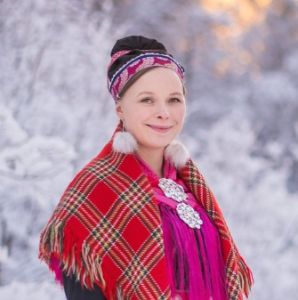Certification marks help both Sami artisans and consumers, says council

With more people purchasing Sami handicrafts and arts, the Saami Council says the recent launch of special trademarks will help both Sami artisans and consumers.
“The Sami community has noticed an increased interest in our culture but also an increasing amount of copying of our arts as well as cultural appropriation,” Sandra Márjá West, the project leader from the Saami Council Cultural Unit, told Eye on the Arctic.
“So this project has been in the works for a long time.”
The project saw two trademarks released in December: a renewed “Sámi Duodji” trademark, and a separate, new, “Sámi Made” trademark.
West says the two new symbols can reassure consumers that the Sami handicraft or product they’re purchasing was actually made by a Sami artisan.
“We feel someone buying a Sami handicraft, having the choice, would prefer to purchase one made by a Sami person,” West said. “[The trademarks] protect the consumer and help strengthen business opportunities for Sami.”
Traditional handicrafts
The Saami Council is the NGO that promotes the rights and pan-Arctic interests of the estimated 100,000 to 150,000 Saami in Finland, Sweden, Norway and Russia – the Saami homeland collectively referred to as Sapmi.
Saami handicrafts (duodji) can include anything from knives to traditional wooden cups.
The creation of the original “Sámi Duodji” trademark goes back to the 1980s and was established with the Sami handicraft organisation.

However, the organization and the council decided to renew the trademark and rework how it functions in response to the number of items still being sold in Arctic Europe that purport to be by Sami when they aren’t.
“We’ve seen this problem increasing in the areas where tourism is growing,” West said.
“In the beginning, there were a lot of issues with this on the Finnish side, but now, with the resurgence of winter tourism in Norway, I personally see the challenge growing bigger here in northern Norway. It’s really surprising when you’re a local and you see how many shops in the centres are just catering to tourists.”
Responding to new markets
In addition to the trademark relaunch, a new trademark “Sámi Made” was also unveiled at the same time to cover items that weren’t handicrafts.
“When the council started work on renewing the trade mark, together with the Sami handicraft organization, the need was identified to have a different trademark for products like designs, books and jewellery or other physical products,” West said.
To use trademarks, Sami artists or artisans will need to make an application on line.
A committee will review the applications and issue the personal licensing number.
With the number, consumers can also go online, and look up information about who has made the product.
“It will make it easier for us to control and ensure the trademarks aren’t misused or copied by people that don’t have a license,” West said.
A societal project
West said she hopes the trademarks are embraced across Sapmi and that the initiative is about more then just commerce, it’s about affirming identity across the Sami homeland.
“It’s important that we have this as a societal project,” West said. “The more Sami families, handicrafters, designers, producers and companies embrace the trademarks, the stronger it will be.
“For a small Indigenous nation like us, I hope the trademarks can be a strong way to communicate with a big international world.”
Links to apply for the trademarks are on the Sami Trademarks website.
Write to Eilís Quinn at eilis.quinn(at)cbc.ca
Related stories from around the North:
Canada: Toronto gallery next stop for travelling Kenojuak Ashevak exhibition, Eye on the Arctic
Russia: German project to house everything published in Siberian and Arctic languages to seek new funding, Eye on the Arctic
Sweden: 2022 Gollegiella Nordic Sami language prize awarded in Stockholm, Eye on the Arctic
United States: How Inuit culture helped unlock power of classical score for Inupiaq violinist, Eye on the Arctic



